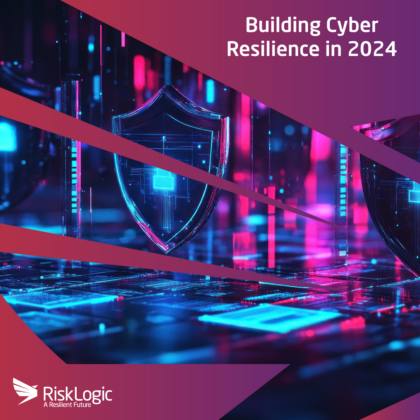-
Url copied to clipboard.
In the modern digital realm, cyber resilience has surfaced as a crucial tool for the growth of any organisation. It’s more than a buzzword, presenting itself as a crucial aspect of the blueprint for organisations from diverse sectors, irrespective of size.
Cyber resilience is the capacity of an organisation to adequately prepare for, respond to, and recover from cyber threats. The aim is to cause as little disruption to operations as possible. Efficient cyber resilience involves an anticipatory approach to potential threats, lowering their overall impacts, and reinforcing an environment that can weather the storm of a cyber breach and still stand tall.
How though, do effective cyber resilience strategies function to protect your business? The answer is multifaceted – blending risk management, cybersecurity principles, and by promoting business continuity.
Read more down below to find a break-down of an efficient cyber resilience plan:
1- Anticipating Threats
The first line of defence in any cyber resilience strategy involves the proactive identification and prediction of potential threats. By leveraging intelligence-led insights and data analytics, organisations can stay one step ahead of cyber malefactors, safeguarding against everything from cybercriminals to internal threats.
The art of anticipation centers around the ability to recognise patterns and extrapolate potential future scenarios. This allows organisations to anticipate and effectively plan for an array of cyber attacks. Whether it’s phishing, ransomware, data breaches or insider threats, an efficient cyber resilience strategy prepares you for them all.
It’s also essential to realise that cyber threats aren’t solely external. Inside threats, whether intentional or accidental, account for a significant portion of cyber incidents. Threat intelligence can help in identifying and anticipating unusual employee behaviour that might indicate a potential misuse of access privileges.
Therefore, equipping your staff with the right kind of knowledge is extremely important. Regular training and awareness programs build a culture of vigilance, preparing your team to identify and respond to threats swiftly, thus mitigating any potential harm.
Being proactive rather than reactive in threat anticipation could be the defining factor between minimal damage and catastrophic loss. With robust cyber resilience strategies, your organisation is not only prepared for the threats of today, but also for the evolving challenges of tomorrow.
2- Implementing Robust Security Measures
The backbone of cyber resilience is a robust cybersecurity framework. This includes the use of high-tech firewalls, encryption that fortifies sensitive data, multi-factor authentication methods, and routine patching and updates.
A well-rounded and robust security framework goes a long way in fending off common cyber threats. Reliable firewalls function as the first line of defence, filtering out suspicious or harmful incoming traffic, while state-of-the-art encryption tools help safeguard sensitive data, both at rest and in transit.
The role of multi-factor authentication in providing an additional layer of security is vital in a resilient cybersecurity framework. By requiring more than one method of verifying a user’s identity, it greatly reduces the risk of unauthorised access.
Yet, even the most advanced systems are only as secure as their latest update. Regular patch management ensures your software is secured against known vulnerabilities, while constant updates keep your systems compatible and optimally functioning in a rapidly evolving digital ecosystem.
Having these tools and technologies available to your organisation is invaluable against threats that may have never been encountered before. As these threats are dealt with, they can be added to your resilience plans and anticipated more accurately in the future.
3- Training and Awareness
Perhaps the most effective tool against cyber threats is your people. A single ill-judged click on a malicious link can spell disaster, cascading into a myriad of unexpected cyber threat events. It is the responsibility of each individual to understand and abide by the principles of cyber safety. Regular trainings and routine awareness programs can equip your personnel to detect threats and prevent breaches.
The aim isn’t just to develop technical acumen but also to foster a culture of cyber vigilance that is ingrained in your day-to-day operations.
Training programs should not be designed as a one-size-fits-all model. Instead, they should be stratified according to different roles within the organisation. Frontline staff may require training that emphasises recognising and responding to phishing attempts, while management-level personnel might benefit from sessions focusing on recognising breaches of best practices tied to the use of customer data.
In addition, establishing clear communication channels for reporting potential threats is vital. Quick action in response to a well-informed warning can save an organisation from serious damage or downtime.
Cyber resilience isn’t simply about implementing technology but developing a proactive and knowledgeable workforce. With a well-trained and cyber-aware team, you can seriously strengthen your defence against cyber threats and fortify your business’s resilience, irrespective of the digital landscape’s dynamic nature.
4- Developing a Response Plan
No system, irrespective of the technology used, is impervious to breaches. Proper cyber resilience strategies are aware of this fact and include incident response plans in their framework. These plans are essentially blueprints that clearly define the course of action when facing a cyber-attack, reducing the response and recovery period.
In the unfortunate event of a breach, time becomes your most precious, yet fleeting, asset. Every second can make a difference between minor disruptions and major losses. Here’s where a thoroughly developed response plan comes into play. Detailed and planned in advance, these contingency mechanisms can help you spring into action without delay, saving precious time, and reducing the ramifications of the breach.
A sound incident response plan should map out clear responsibilities and escalation paths, ensuring no confusion arises during crisis scenarios. It ideally includes clear protocols for identifying and isolating the compromised component of the system, notifying the relevant authorities and stakeholders, and addressing legal or PR concerns.
5- Regular Testing and Review
Cyber threats are not a static enemy but instead evolve rapidly, becoming ever more sophisticated.
At the heart of cyber resilience lies an important principle – the constancy of change. As cyber threats continue to evolve and make use of increasingly sophisticated tactics, an effective cyber resilience strategy demands constant adaptation. This requires a cycle of frequent testing and reviews, allowing organisations to identify potential weak spots and make timely improvements.
Conducting periodic audits of your cybersecurity infrastructure and practices, checking for outdated software, flawed configurations, and potential vulnerabilities yet to be patched are all necessary in an evolving cyber landscape. It’s important to also ask the question continuously; are there emerging tactics or types of attacks that your current strategy may not be adequately equipped to deal with? Routine assessments help identify these, ensuring you’re not caught off guard.
Beyond technology, regular reviews should also extend to training and awareness initiatives. Are the existing programs effectively engaging employees? Are there ways to improve their reach or effectiveness? Such assessments can help keep awareness programs relevant and impactful.
RiskLogic distinguishes itself as a leader in providing cyber resilience solutions that are tailored, comprehensive, and potent enough to safeguard organisations amidst the rapidly transforming digital environment. Our cyber resilience solutions are specifically crafted to empower organisations to withstand cyber threats and swiftly rebound from attacks, thereby protecting critical operations, preserving reputation, and safeguarding the financial health of your organisation.
If an organisation is to flourish amidst an ever-evolving digital environment, robust cyber resilience quickly transforms from a mere option to a non-negotiable instrument in the arsenal, safeguarding organisational priorities and assets.
Contact RiskLogic to explore Cyber Resilience Management solutions









